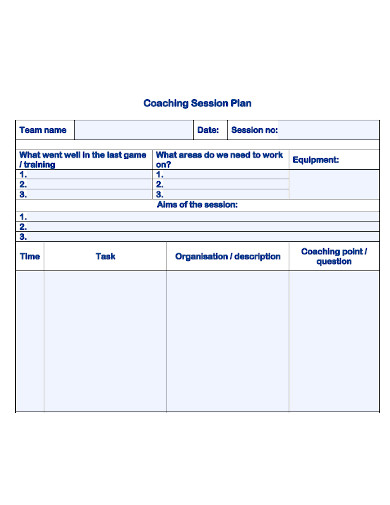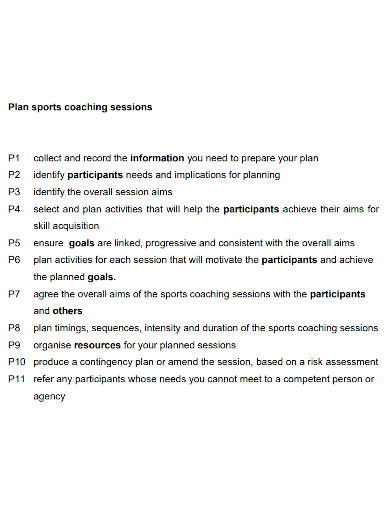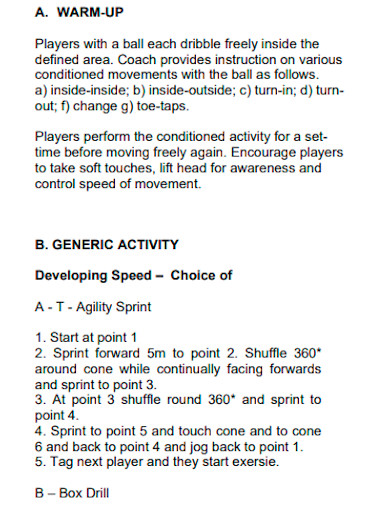Every sport needs a coach who is an expert in a certain field. A coach needs to know all the aspects of the sports he is teaching the athletes for. Since a coach is understandably well educated in his profession, he also needs some guidance to do his training sessions smoothly. To do this, he needs to have a sports plan to do all the things he needs to do to proceed with the training sessions. The importance of having proper planning for a coach is that things will be more organized, systematic, and goals are likely to succeed. If you want to know how to make a sports coaching plan, read the article and refer to the sports coaching plan templates below to guide you in making one.
4+ Sports Coaching Plan Samples
1. Sports Coaching Plan Sample
2. Sports Coaching Lesson Plan
3. Printable Sports Coaching Plan
4. Editable Sports Coaching Plan
5. Sports Coaching Action Plan
What is a Sports Coaching Plan?
A sports coaching plan is the result of developing strategies to achieve goals and objectives, address concerns, and facilitate all the actions that need to be done.
Guidelines on Planning a Sports Coaching Session
Identify your Objectives
Before you dive in and start your coaching session, assess first the demographics of the participants so you can identify your objectives. You need to be prepared so you won’t run into problems later.
First, find out the age of the participants, level of experience in the sport you’re coaching, their abilities and skills, their special requirement relating to their health or culture, and the number of participants who will join the session.
Once you’ve gathered this information you can now proceed on finding out your objectives. By making your objectives, ask yourself these following questions:
Who are the participants? What are their skill levels? What will be the starting point?
What are their end goals? What are their expectations?
How will you achieve their expectations?
What facilities and equipment do you need?
How will we determine whether they have improved or not?
These questions will guide you in making your objectives clear and concise.
Carry Out Your Tasks and Address the Needs of the Participants
Once you’ve set your goals and objectives, it’s time to put your assigned tasks and responsibilities into action. When in training sessions, it is expected that everyone performs differently. Some may improve greatly, some may struggle. Your responsibility as a coach is to be flexible enough to help your participants in the areas they need to improve. You are there to mentor them and at the same time encourage them to persevere. Other responsibilities you need to do are to make sure the sessions are fun and safe so participants can be more at ease and less conscious of doing the activities.
Create a Contingency plan
Making a coaching plan is a great way to guide you in carrying out your sessions, but sometimes things don’t always go according to plan. A lot of factors can affect your plan, and you need to be ready to deal with situations that you might not expect to happen. Factors that can affect your sessions are weather disturbances, illness, accidents, not enough participants for the sessions, facilities are booked, etc. By creating a contingency plan or Plan B, you are ready to face these challenges without your sessions being interrupted. Make sure your Plan B covers all of the possible situations that might happen in your sessions.
Plan Out the Components of the Session
The components of your sessions must consist of the following:
- Warm-up
Before a session begins, you should plan on what warm-ups to do depending on the time and place your sessions are going to be held. Warm-ups are important to help reduce the risk of injury. - Main Event
This section is where you practice the participants’ skills and techniques of the sport you’re training them. Align the drills and practices to the sport your participants are mastering at. The practices will help participants improve their physical skills. - Cool Down
Once you’ve spent enough time on practices and your participants have grown weary and you need to wrap up the session, set aside some time for them to cool down. This will help make your participants feel relaxed after rigorous activity.
Lastly, don’t forget to give feedback to your participants on their progress. The feedback will let them be aware of the areas they need to improve or if they have been doing great progress in their training.
FAQs
What are the three types of coaching styles?
The three types of coaching styles in sports are: holistic, authoritarian, and autocratic.
What are the roles of a sports coach?
The general responsibilities of every sports coach are: teaching relevant skills and tactics to athletes, monitoring and enhancing performance through encouragement and constructive feedback, identifying all strengths and weaknesses, giving advice to health and lifestyle issues, and developing training programs.
What sports that are easy to coach?
The sports that are easy to coach with and easy to play are soccer, tennis, basketball, table tennis, wrestling, golf, and swimming, just to name a few.
Coaching a group of people in a certain sport isn’t a piece of cake but it is fun and the improved results of the athletes are rewarding. Having a plan can help ease the burden of organizing a sports activity. To learn more about creating plans for different events or organizations, click on the templates to learn the tips provided. This also comes with printable and downloadable templates that you can customize to your own liking.
Related Posts
FREE 9+ 30-Day Marketing Plan Samples in PDF | MS Word | Apple Pages | Google Docs
FREE 3+ Sales Team Action Plan Samples in PDF | MS Word | Apple Pages | Google Docs
Marketing Plan For Small Business Samples
FREE 7+ Fashion Business Plan Samples in PDF
FREE 10+ Sprint Planning Samples In MS Word | Google Docs | PDF
FREE 10+ Wedding Planning Samples in MS Word | Apple Pages | Powerpoint | PDF
FREE 9+ Monthly Study Planner Samples in PSD | Illustrator | InDesign | PDF
FREE 9+ Sample Curriculum Planning Templates in PDF | MS Word
FREE 10+ Teacher Development Plan Samples in MS Word | Google Docs | Apple Pages | PDF
FREE 10+ Basketball Practice Plan Samples in PDF
FREE 12+ School Business Plan Samples in PDF | MS Word | Apple Pages | Google Docs
FREE 7+ Client Strategic Plan Samples in PDF | MS Word
FREE 11+ Trucking Business Plan Templates in PDF | MS Word | Google Docs | Pages
FREE 7+ Small Hotel Business Plan Samples PDF | MS Word | Apple Pages | Google Docs
FREE 14+ Bakery Business Plans in MS Word | PDF | Google Docs | Pages





